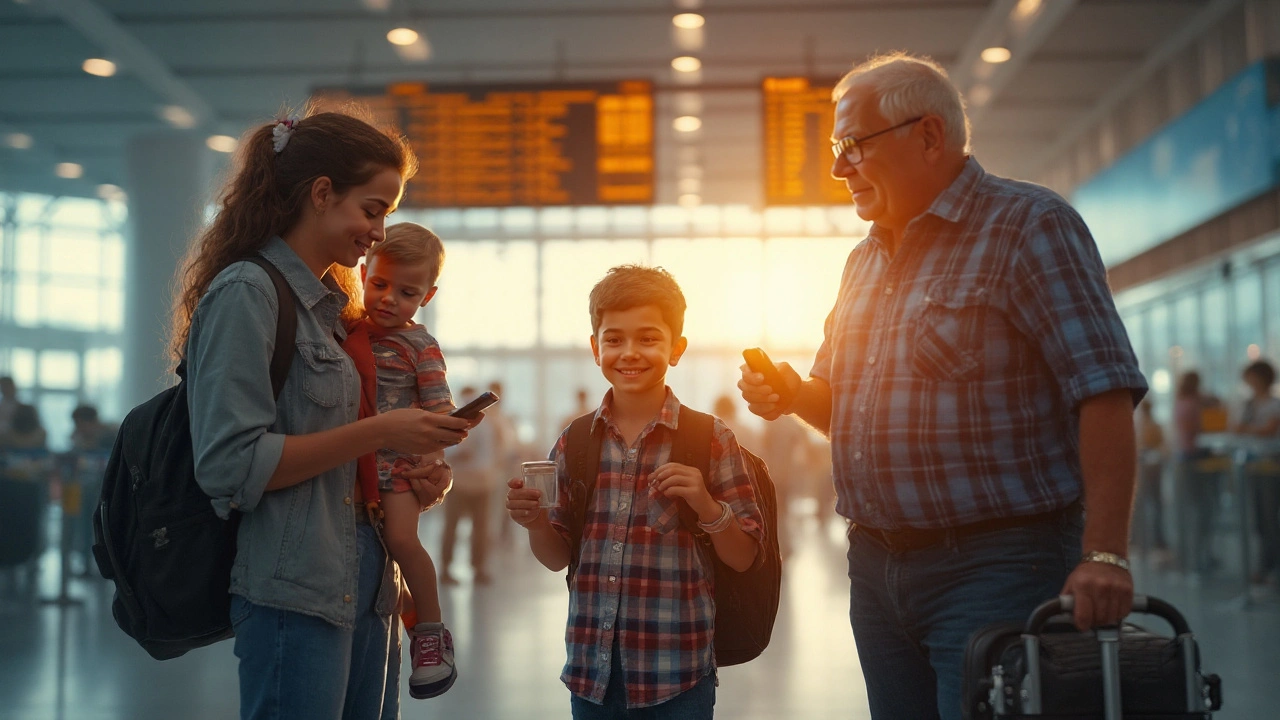Allergic Disorder Travel Management is a set of strategies, tools and precautions that help people with allergic disorders travel safely, stay comfortable and enjoy their destination. Whether you’re heading to a tropical beach or a bustling city, the right plan can turn a potential nightmare into a memorable adventure.
Know Your Allergies Before You Go
Start by listing every known trigger. Food Allergy is an immune response to specific foods such as peanuts, shellfish or gluten often demands extra vigilance at restaurants. Environmental Allergy covers reactions to pollen, dust mites, animal dander and mold spores becomes a bigger deal when you’re visiting high‑pollen regions or older hotels. Jot these down, rank them by severity and keep the list handy on your phone and in your wallet.
Pack a Complete Medical Kit
The cornerstone of any allergy‑aware traveler is a well‑stocked kit. Include:
- Antihistamine non‑sedating tablets or liquid like cetirizine, loratadine, or fexofenadine for mild reactions.
- Epinephrine Auto‑Injector a single‑dose device that delivers 0.3mg (adults) or 0.15mg (children) of epinephrine for anaphylaxis. Carry at least two, each in a separate bag.
- A written Emergency Action Plan outlines step‑by‑step what to do if a severe reaction occurs, including contact numbers for local emergency services.
- A Medical Alert Bracelet identifies your allergy type and emergency medication in case you lose consciousness.
Store these items in an easy‑to‑reach carry‑on and in your checked luggage-never rely on a single location.
Choosing the Right Epinephrine Auto‑Injector
| Brand | Dose (mg) | Price (USD) | Device Size |
|---|---|---|---|
| EpiPen | 0.3 (adult) / 0.15 (child) | ≈75 | Medium |
| Auvi‑Q | 0.3 / 0.15 | ≈135 | Compact (voice‑guided) |
| Adrenaclick | 0.3 / 0.15 | ≈60 | Standard |
When picking a device, consider price, size and whether you prefer voice prompts (Auvi‑Q). Remember that some countries require a prescription, so arrange a refill before departure.
Food Safety on the Road
Dining out is part of the fun, but it can be risky. Follow these steps:
- Research local cuisine before you arrive. Identify dishes that commonly contain hidden allergens.
- Learn key phrases in the local language. For example, "I am allergic to peanuts" translates to "Soy alérgico/a a los cacahuetes" in Spanish.
- Ask staff about preparation methods. If a kitchen cannot guarantee a nut‑free environment, choose a simple grilled protein with plain sides.
- Carry a small Allergy Card a printed card listing your allergens in the local language. Hand it to the waiter and request a verbal confirmation.
- Always have antihistamines and an epinephrine auto‑injector within arm’s reach while eating.
These habits dramatically lower the odds of an accidental exposure.
Managing Environmental Triggers
Even if your food is safe, pollen, dust mites or mold can ruin a trip.
- Seasonal timing: Check pollen forecasts for your destination (many meteorological services publish daily counts). Plan indoor activities on high‑pollen days.
- Accommodation choice: Look for hotels with Allergy‑Friendly Hotel Certification a program that verifies rooms are free of carpet, have HEPA filters and use hypoallergenic linens. Booking.com and Airbnb often label such properties.
- Room prep: Arrive early, open windows for ventilation, request a dust‑free room, and bring a portable air purifier if you’re highly sensitive.
- Outdoor gear: Pack a lightweight mask for high‑pollen hikes and a compact vacuum‑cleaned pillowcase for airline seats.

Travel Insurance with Allergy Coverage
Not all policies cover emergencies related to allergies. Look for a plan that explicitly lists:
- Hospitalisation for anaphylaxis.
- Re‑prescription of epinephrine auto‑injectors abroad.
- Medical evacuation if you’re in a remote area.
Companies such as World Nomads and Allianz offer add‑ons for pre‑existing conditions, often for an extra $30‑$70 per year.
Airport Security and In‑Flight Considerations
Security scanners can be intimidating, but you have rights. Carry a doctor’s note (or a clear label on your medication) explaining the necessity of auto‑injectors and liquid antihistamines. Most airlines allow you to keep epinephrine with you, and you can request a seat away from strong smells if you have a respiratory allergy.
During the flight, stay hydrated, avoid alcohol (it can increase reaction severity) and keep your medication within arm’s reach-not in the overhead bin.
Real‑World Scenarios & Quick Fixes
Here are three brief stories that illustrate how preparation makes a difference:
- Thailand street food: A traveler with a shellfish allergy asked for a “no seafood” grill. The chef confirmed no cross‑contamination. The diner still carried an antihistamine and felt confident enjoying the meal.
- Swiss alpine hike: High pollen levels triggered sneezing for a hay‑fever sufferer. She used a portable HEPA mask, took a non‑sedating antihistamine, and avoided the valley on the worst‑forecast day, completing the trek without symptoms.
- NYC subway incident: A commuter’s peanut‑butter sandwich fell on the floor. He quickly used his epinephrine injector after a mild reaction, called emergency services, and was treated on the spot, preventing a severe episode.
Each scenario shares one thread: a clear plan, accessible medication, and communication.
Putting It All Together - A Pre‑Travel Checklist
- Document every allergy (food, environmental, drug) in writing.
- Obtain a prescription for at least two epinephrine auto‑injectors; verify travel‑friendly packaging.
- Create and print an Emergency Action Plan in the destination’s language.
- Buy travel insurance that covers allergy‑related emergencies.
- Reserve an allergy‑friendly accommodation and request a dust‑free room.
- Pack a small medical alert card and a digital copy on your phone.
- Check pollen forecasts and adjust outdoor plans accordingly.
- Confirm airline policies for medication and request seat preferences if needed.
Follow this list, and you’ll be ready to focus on sights, not symptoms.
Frequently Asked Questions
Can I bring my epinephrine auto‑injector on a plane?
Yes. TSA and most international agencies allow auto‑injectors in carry‑on bags. Carry a doctor’s note or label the device, and be prepared for a brief inspection.
What if my prescription isn’t accepted in the destination country?
Contact the local embassy or consulate before you travel. They can provide a temporary import permit or direct you to a pharmacy that stocks the required medication.
How can I identify allergen‑free meals abroad?
Use an allergy card in the native language, ask for “plain” preparations, and avoid dishes with sauces or shared fryers. When in doubt, choose grilled meat or fish with steamed vegetables.
Do travel insurance policies really cover anaphylaxis?
Only policies that explicitly list pre‑existing medical conditions. Look for clauses covering emergency medication, hospitalisation, and medical evacuation for allergic reactions.
Is a medical alert bracelet necessary if I carry a card?
Both are useful. A bracelet works when you’re unconscious or can’t speak; a card provides detailed information for caregivers. Using both maximises safety.
What should I do if I experience a mild reaction while traveling?
Take a non‑sedating antihistamine immediately. Monitor symptoms for 30‑45 minutes. If swelling spreads, breathing becomes difficult, or you feel faint, use your epinephrine auto‑injector and call emergency services.





Ryan Tanner
Just got back from Thailand and this guide saved my life 🙌 I had a shellfish scare at a street stall but my allergy card + epinephrine kept me chill. Seriously, if you're allergic and you travel - do this stuff. No excuses.
Jessica Adelle
This article is dangerously irresponsible. Epinephrine auto-injectors are not toys. The casual tone, the lack of FDA-approved dosage emphasis, and the suggestion that 'simple grilled protein' is safe - this could get someone killed. Americans are too lazy to take medical responsibility seriously.
Emily Barfield
What if... what if the epinephrine doesn't work? What if the airline denies you boarding because your injector looks 'suspicious'? What if the hotel's 'allergy-friendly' label is just marketing fluff? We live in a world where safety is performative, not real - and this guide, while well-intentioned, is just another bandage on a hemorrhage of systemic neglect!!
Sai Ahmed
Who really checks pollen forecasts? I think governments plant allergens to control populations. Also, why do they make epinephrine so expensive? Big Pharma owns everything. I didn't even know there were three brands - I just use whatever my cousin brings from India. Works fine.
Albert Schueller
Epinephrine isn't a snack. You need to carry TWO? That's ridiculous. And why does everyone assume you're American? In Europe, you need a prescription for everything - even aspirin. This guide is full of typos too - 'epinephrine' misspelled twice. I'm not even gonna bother with the rest.
Ted Carr
Oh, so now we’re supposed to carry a printed card in 47 languages? Next they’ll ask us to memorize the entire dictionary of 'I am allergic to everything'. I’ve been traveling for 20 years with a peanut allergy. I just don’t eat anything that looks like it could have been made by a human. Works every time.
Rebecca Parkos
THIS IS THE MOST IMPORTANT THING I’VE READ ALL YEAR. I have a daughter with anaphylaxis and we’ve been traveling since she was 2. You don’t know what it’s like until you’re in a rural village in Peru with no pharmacy and your kid’s throat closing. THIS CHECKLIST SAVED HER LIFE. THANK YOU.
Bradley Mulliner
Let’s be real - this is just fearmongering dressed as advice. Most people who carry epinephrine are just anxious. The real issue is that modern society has made us fragile. You don’t need a HEPA pillowcase. You need to toughen up. Also, travel insurance for allergies? That’s a scam. You’re just paying to feel safe.
Rahul hossain
Brilliant article - but I must say, the Western obsession with 'certified allergy-friendly hotels' is laughable. In India, we just ask the cook, hand him a note in Hindi, and he bows. No HEPA filters needed. You don’t need to over-engineer safety - you need respect. And a little humility.
Reginald Maarten
Actually, the article misstates the dose for children. The standard pediatric dose is 0.15mg - not '0.15mg (children)' as written. Also, Auvi-Q was discontinued in the U.S. in 2015 and relaunched in 2023 - the price comparison is outdated. And 'non-sedating antihistamines' - technically, all antihistamines are sedating to some degree. The distinction is relative. This guide is full of oversimplifications and factual inaccuracies.
Jonathan Debo
Let’s be honest - this is the kind of advice that makes people feel safe while actually creating a false sense of security. You can’t 'manage' allergies with checklists. You can only mitigate risk - and even then, the human element - the chef who forgets, the airline attendant who doesn’t care - is the real variable. This is performative preparedness. The real solution? Avoid travel entirely. Or, better yet - don’t be allergic.
Robin Annison
I’ve been living with seasonal allergies for 15 years. What this guide misses is the emotional toll. It’s not just about the epinephrine or the cards - it’s about the loneliness of always being the one who can’t eat, can’t stay, can’t relax. The real magic isn’t in the checklist. It’s in the people who listen - the waiter who says 'I’ll make sure', the friend who brings their own snacks. That’s what makes travel possible.
Abigail Jubb
I cried reading this. Not because I’m grateful - because I’m exhausted. Every trip feels like a hostage negotiation with a restaurant, a hotel, and fate itself. I carry five epinephrine pens. I wear a bracelet. I have a laminated card in six languages. And still - I feel like I’m always one bite away from dying. This guide? It’s just a mirror. And the reflection is terrifying.
George Clark-Roden
There’s something profoundly human here - the way we cling to lists, to devices, to protocols, because the world is too chaotic to trust. But the real power isn’t in the auto-injector - it’s in the moment when a stranger in Kyoto sees your card, nods, and brings you a plate with nothing but rice, grilled fish, and silence. That’s the medicine no checklist can give you.
Hope NewYork
why do ppl make this so hard? i just dont eat stuff that looks weird. also, epinephrine is overrated. i had a reaction once and took benadryl and slept it off. no big deal. hotels? just pick a new one if it smells dusty. duh.
Bonnie Sanders Bartlett
I’m a nurse and I’ve traveled with my son who has severe allergies for years. This guide is spot-on. Simple, practical, and compassionate. The most important thing? Don’t be afraid to ask. Say 'I’m allergic' like it’s normal - because it is. And always, always keep meds with you. Not in the suitcase. Not in the overhead. In your hand.
Melissa Delong
Who authorized this guide? The FDA doesn’t endorse any of these brands. The WHO doesn’t recognize 'allergy-friendly hotel' as a standard. This is misinformation disguised as helpful advice. You’re being manipulated into buying expensive devices and insurance. Don’t fall for it. The real solution? Stay home.
Marshall Washick
I’ve traveled to 42 countries with a peanut allergy. The one thing I’ve learned? It’s not about the gear. It’s about the quiet moments - when a taxi driver in Marrakech sees your bracelet and gives you bottled water without being asked. Or when a grandmother in Vietnam insists you eat her homemade rice cake - and then watches you eat it, just to make sure. That’s the real safety net.
Abha Nakra
As someone from India who’s traveled with severe pollen allergies, I can confirm: the HEPA mask and portable purifier are game-changers. But the real hero? The local pharmacy in Goa who, without being asked, handed me a bottle of antihistamine and said, 'For you, no charge.' Kindness travels farther than any checklist.
Neal Burton
This is all so performative. You carry a bracelet? A card? An injector? You’re still just a walking liability. The world doesn’t owe you comfort. If you can’t handle a little dust or a stray peanut, maybe you shouldn’t leave your house. Travel is supposed to be uncomfortable. That’s the point.